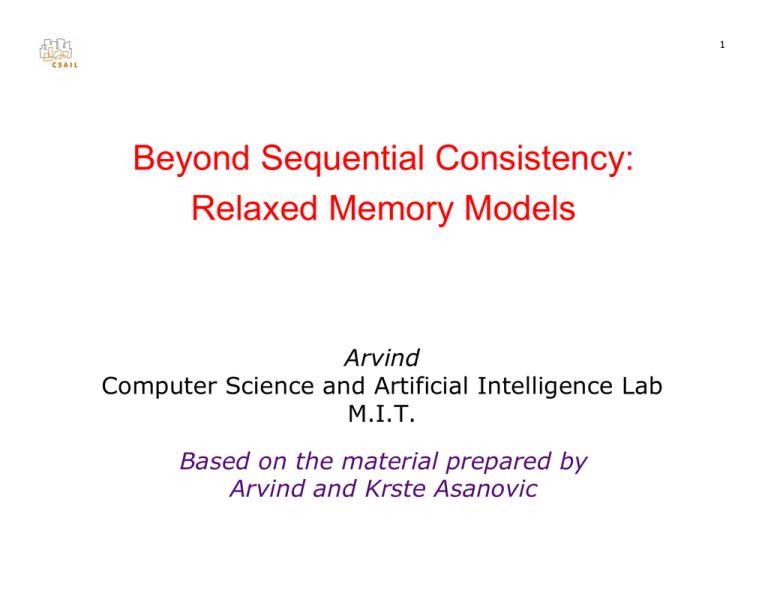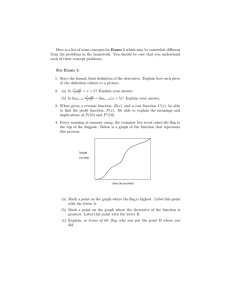Document 13548520
advertisement

1 Beyond Sequential Consistency: Relaxed Memory Models Arvind Computer Science and Artificial Intelligence Lab M.I.T. Based on the material prepared by Arvind and Krste Asanovic 2 Beyond Sequential Consistency: Relaxed Memory Models 6.823 L20- 3 Arvind Sequential Consistency Processor 1 Processor 2 Store(a,10); Store(flag,1); L: r1 = Load(flag); J z(r1,L); r2 = Load(a); initially flag = 0 • In-order instruction execution • Atomic loads and stores SC is easy to understand but architects and compiler writers want to violate it for performance November 21, 2005 Memory Model Issues Architectural optimizations that are correct for uniprocessors, often violate sequential consistency and result in a new memory model for multiprocessors November 21, 2005 6.823 L20- 4 Arvind 6.823 L20- 5 Arvind Example 1: Store Buffers Process 1 Process 2 Store(flag1,1); r1 := Load(flag2); Store(flag2,1); r2 := Load(flag1); Question: Is it possible that r1=0 and r2=0? • Sequential consistency: No • Suppose Loads can bypass stores in the store buffer: Yes ! Total Store Order (TSO): IBM 370, Sparc’s TSO memory model Initially, all memory locations contain zeros November 21, 2005 6.823 L20- 6 Arvind Example 2: Short-circuiting Process 1 Process 2 Store(flag1,1); r3 := Load(flag1); r1 := Load(flag2); Store(flag2,1); r4 := Load(flag2); r2 := Load(flag1); Question: Do extra Loads have any effect? • Sequential consistency: No • Suppose Load-Store short-circuiting is permitted in the store buffer – No effect in Sparc’s TSO model – A Load acts as a barrier on other loads in IBM 370 November 21, 2005 6.823 L20- 7 Arvind Example 3: Non-FIFO Store buffers Process 1 Process 2 Store(a,1); Store(flag,1); r1 := Load(flag); r2 := Load(a); Question: Is it possible that r1=1 but r2=0? • Sequential consistency: No • With non-FIFO store buffers: Yes Sparc’s PSO memory model November 21, 2005 6.823 L20- 8 Arvind Example 4: Non-Blocking Caches Process 1 Process 2 Store(a,1); Store(flag,1); r1 := Load(flag); r2 := Load(a); Question: Is it possible that r1=1 but r2=0? • Sequential consistency: No • Assuming stores are ordered: Yes because Loads can be reordered Sparc’s RMO, PowerPC’s WO, Alpha November 21, 2005 6.823 L20- 9 Arvind Example 5: Register Renaming Process 1 Process 2 Store(flag1,r1); r1 := Load(flag2); Store(flag2,r2); r2 := Load(flag1); Register renaming will eliminate this edge Initially both r1 and r2 contain 1. Question: Is it possible that r1=0 but r2=0? • Sequential consistency: No • Register renaming: Yes because it removes anti-dependencies November 21, 2005 6.823 L20- 10 Arvind Example 6: Speculative Execution Process 1 Store(a,1); Store(flag,1); Process 2 L: r1 := Load(flag); Jz(r1,L); r2 := Load(a); Question: Is it possible that r1=1 but r2=0? • Sequential consistency: No • With speculative loads: Yes even if the stores are ordered November 21, 2005 6.823 L20- 11 Arvind Example 7: Store Atomicity Process 1 Process 2 Process 3 Store(a,1); Store(a,2); r1 := Load(a); r3 := Load(a); r2 := Load(a); r4 := Load(a); Process 4 Question: Is it possible that r1=1 and r2=2 but r3=2 and r4=1 ? • Sequential consistency: No • Even if Loads on a processor are ordered, the different ordering of stores can be observed if the Store operation is not atomic. November 21, 2005 6.823 L20- 12 Arvind Example 8: Causality Process 1 Process 2 Process 3 Store(flag1,1); r1 := Load(flag1); r2 := Load(flag2); Store(flag2,1); r3 := Load(flag1); Question: Is it possible that r1=1 and r2=1 but r3=0 ? • Sequential consistency: No November 21, 2005 13 Five-minute break to stretch your legs Weaker Memory Models & Memory Fence Instructions 6.823 L20- 14 Arvind • Architectures with weaker memory models provide memory fence instructions to prevent the permitted reorderings of loads and stores Store(a1, v); The Load and Store can be reordered if a1 =/= a2. Insertion of Fencewr will disallow this reordering Fencewr Load(a2); Similarly: Fencerr; Fencerw; Fenceww; SUN’s Sparc: MEMBAR; MEMBARRR; MEMBARRW; MEMBARWR; MEMBARWW PowerPC: Sync; EIEIO November 21, 2005 6.823 L20- 15 Arvind Enforcing SC using Fences Processor 1 Store(a,10); Store(flag,1); Processor 2 L: r1 = Load(flag); Jz(r1,L); r2 = Load(a); Processor 1 Store(a,10); Fenceww; Store(flag,1); Processor 2 L: r1 = Load(flag); Jz(r1,L); Fencerr; = Load(a); Weak ordering November 21, 2005 r2 6.823 L20- 16 Arvind Weaker (Relaxed) Memory Models Alpha, Sparc PowerPC, ... Store is globally performed TSO, PSO, RMO, ... Writebuffers RMO=WO? SMP, DSM • Hard to understand and remember • Unstable - Modèle de l’année November 21, 2005 Backlash in the architecture community • Abandon weaker memory models in favor of SC by employing aggressive “speculative execution” tricks. – all modern microprocessors have some ability to execute instructions speculatively, i.e., ability to kill instructions if something goes wrong (e.g. branch prediction) – treat all loads and stores that are executed out of order as speculative and kill them if a signal is received from some other processor indicating that SC is about to be violated. November 21, 2005 6.823 L20- 17 Arvind 6.823 L20- 18 Arvind Aggressive SC Implementations Loads can go out of order miss hit Processor 1 r1 = Load(flag); r2 = Load(a); Processor 2 Store(a,10); kill Load(a) and the subsequent instructions if Store(a,10) happens before Load(flag) completes • Still not as efficient as weaker memory mode • Scalable for Distributed Shared Memory systems? November 21, 2005 6.823 L20- 19 Arvind Properly Synchronized Programs • Very few programmers do programming that relies on SC; instead higher-level synchronization primitives are used – locks, semaphores, monitors, atomic transactions • A “properly synchronized program” is one where each shared writable variable is protected (say, by a lock) so that there is no race in updating the variable. – There is still race to get the lock – There is no way to check if a program is properly synchronized • For properly synchronized programs, instruction reordering does not matter as long as updated values are committed before leaving a locked region. November 21, 2005 6.823 L20- 20 Arvind Release Consistency • Only care about inter-processor memory ordering at thread synchronization points, not in between • Can treat all synchronization instructions as the only ordering points … Acquire(lock) // All following loads get most recent written values … Read and write shared data .. Release(lock) // All preceding writes are globally visible before // lock is freed. … November 21, 2005





